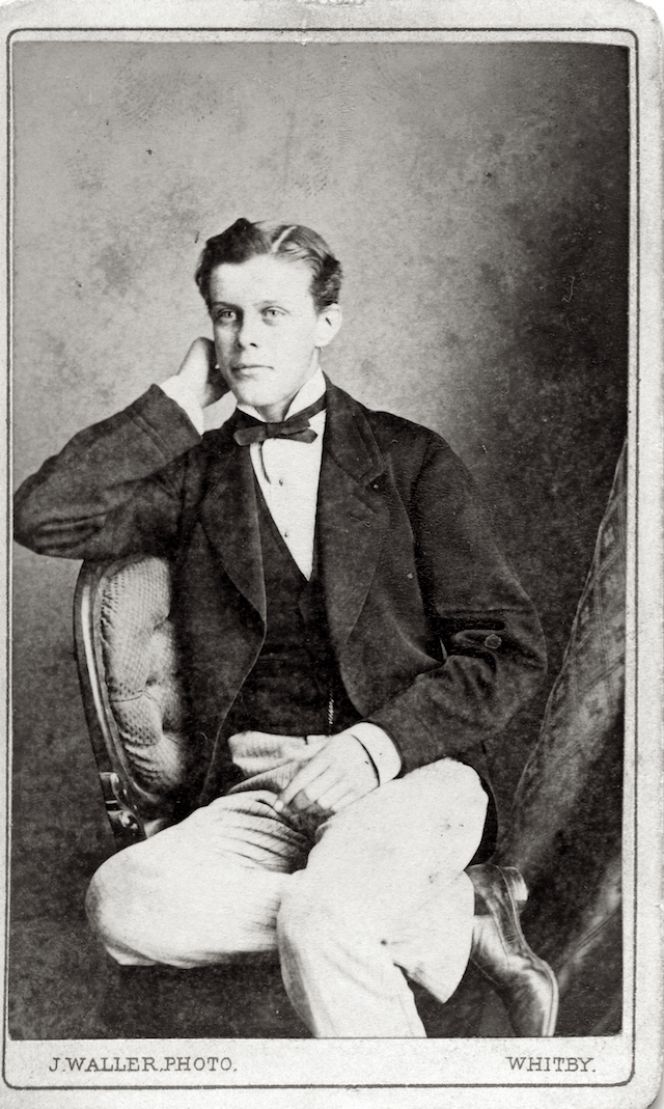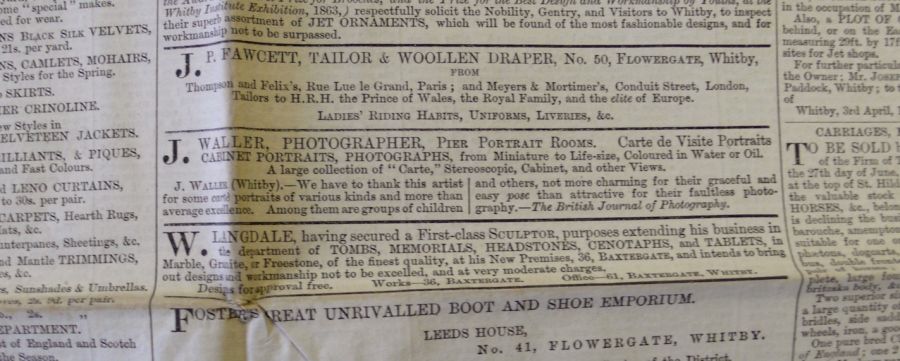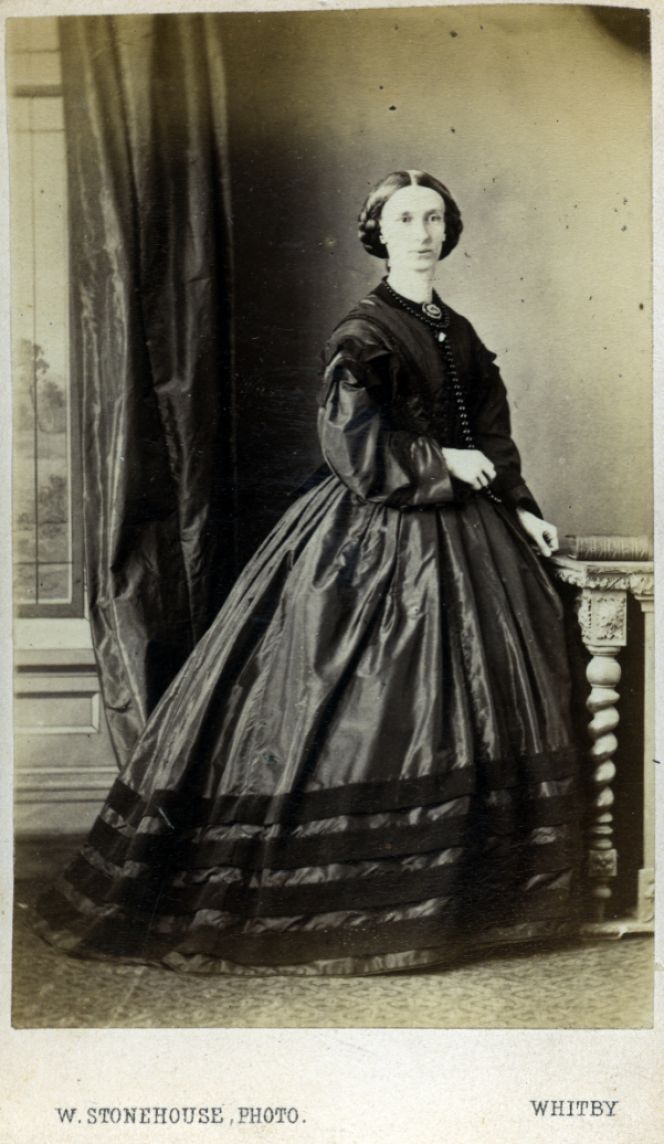ikfoundation.org
The IK Foundation
Promoting Natural & Cultural History
Since 1988


EARLY PHOTOGRAPHIC PORTRAITS
& Victorian Advertising
Whitby photographs depicting textiles and clothing can be traced back to the 1860s, but there is evidence suggesting that a photographic portrait studio was introduced already in 1848 via local advertisements in the 1856 Whitby Gazette – describing that Mr W. Stonehouse’s business had been active ‘for a period of eight years’. This case study will briefly look into his studio and the successor, J. Waller, who, on Saturday, 24 June 1866, noticed ‘The Newly erected studio…’ at Pier Portrait Rooms. According to advertisements, this man continued his photographic work up to 1880. The photographic collection of Whitby Museum also includes quite a substantial number of portraits from these early photographers, which will be illustrated in this essay with two examples.
 A young man portrayed by J. Waller ‘Miniature painter & Photographer Pier Portrait Rooms Whitby’ during the 1870s. The main new development in male fashion at the time was a shorter jacket, while trousers made of different material which contrasted with the dark upper garment had already been common place for at least ten years. The colourful waistcoats with a variety of woven or printed motifs of the 1840s-1860s also became less popular during the last decades of the 19th century. (Courtesy of: Whitby Museum, Photographic Collection).
A young man portrayed by J. Waller ‘Miniature painter & Photographer Pier Portrait Rooms Whitby’ during the 1870s. The main new development in male fashion at the time was a shorter jacket, while trousers made of different material which contrasted with the dark upper garment had already been common place for at least ten years. The colourful waistcoats with a variety of woven or printed motifs of the 1840s-1860s also became less popular during the last decades of the 19th century. (Courtesy of: Whitby Museum, Photographic Collection).The earliest photographs are an important first-hand source for textile research. Still, a certain amount of caution is necessary before drawing conclusions from them since studio portraits were, in particular, always carefully posed down to the last detail and often retouched. Portrait photographs were developed from the old tradition for painted portraits, the difference being that the invention of photography now made it possible for ever more people to be able to afford to immortalise themselves and their families. Portrait painters had often portrayed their subjects as more beautiful than they really were, and the same tradition lived on in Victorian studio photographs. It was vital to choose poses and expressions to show the subject’s most attractive sides and most desirable character traits in the best possible light and backgrounds. Accessories could be used to draw attention to the subject’s social status or station in society.
 Advertisement in Whitby Gazette, June 1870 by J. Waller, Photographer at Pier Portrait Rooms in Whitby (Whitby Museum, Library & Archive). Photo: Viveka Hansen.
Advertisement in Whitby Gazette, June 1870 by J. Waller, Photographer at Pier Portrait Rooms in Whitby (Whitby Museum, Library & Archive). Photo: Viveka Hansen. Advertisement in Whitby Gazette by the same J. Waller, still in his business at the same address in June 1875. What can be understood from his regular notices, he continued up to 1880 with his Portrait workshop at this desirable position, close to the seaside and the still rather newly-built hotels in the West Cliff area. (Whitby Museum, Library & Archive). Photo: Viveka Hansen.
Advertisement in Whitby Gazette by the same J. Waller, still in his business at the same address in June 1875. What can be understood from his regular notices, he continued up to 1880 with his Portrait workshop at this desirable position, close to the seaside and the still rather newly-built hotels in the West Cliff area. (Whitby Museum, Library & Archive). Photo: Viveka Hansen.The predecessor, William Stonehouse, was active in the period from 1848 to circa 1870 at three locations in Whitby. First, it was at Church Street, followed by the same Pier Room that Mr Waller had taken over in 1866, and finally, at Khyber Pass – both the latter addresses were close to the seaside. Stonehouse's advertisement from July 3rd 1856, also gives several enlightening details about his business:
‘Photographic Portraits Taken Daily By
Mr W. Stonehouse Church Street
W.S. has practised the Photographic Art in Whitby
for a period of eight year, and having directed especial
attention to Collodion and Calotype Portraits, he ventures
to assert that his pictures will be found to possess a brilliancy
of tone, and minuteness of detail not surpassed by
the first class London Photographs.
A great reduction to the price of Photographic materials
together with the facility with which Collodion pictures
are produced, enables Mr. Stonehouse to make a
corresponding reduction in the price of his miniatures.
Coloured Portrait in Morocco Case, 2s. 6d.’
 A representative picture taken in 1866 by the photographer W. Stonehouse, The Pier Portrait Rooms, Whitby. This lady is dressed in a dark coloured satin dress decorated with broad velvet ribbons. A dress of this sort required the hand of a professional dressmaker to achieve perfection in cut and sewing. (Courtesy of: Whitby Museum, Photographic Collection).
A representative picture taken in 1866 by the photographer W. Stonehouse, The Pier Portrait Rooms, Whitby. This lady is dressed in a dark coloured satin dress decorated with broad velvet ribbons. A dress of this sort required the hand of a professional dressmaker to achieve perfection in cut and sewing. (Courtesy of: Whitby Museum, Photographic Collection). Sources:
- Hansen, Viveka, The Textile History of Whitby 1700-1914 – A lively coastal town between the North Sea and North York Moors, London & Whitby 2015 (Chapter III).
- Whitby Gazette, 1855-1885 (Whitby Museum, Library & Archive).
- Whitby Museum, Photographic Collection (studies of photographic portraits in 2010).
More in Books & Art:
Essays
The iTEXTILIS is a division of The IK Workshop Society – a global and unique forum for all those interested in Natural & Cultural History from a textile Perspective.
Open Access essays, licensed under Creative Commons and freely accessible, by Textile historian Viveka Hansen, aim to integrate her current research, printed monographs, and earlier projects dating back to the late 1980s. Some essays feature rare archive material originally published in other languages, now available in English for the first time, revealing aspects of history that were previously little known outside northern European countries. Her work also explores various topics, including the textile trade, material culture, cloth manufacturing, fashion, natural dyeing, and the intriguing world of early travelling naturalists – such as the "Linnaean network" – viewed through a global historical lens.
For regular updates and to fully utilise iTEXTILIS' features, we recommend subscribing to our newsletter, iMESSENGER.
been copied to your clipboard




– a truly European organisation since 1988
Legal issues | Forget me | and much more...
You are welcome to use the information and knowledge from
The IK Workshop Society, as long as you follow a few simple rules.
LEARN MORE & I AGREE







